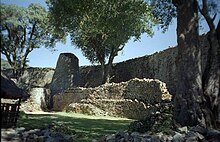
Great Zimbabwe
Great Zimbabwe is a medieval city in the south-eastern hills of Zimbabwe near Lake Mutirikwe and the town of Masvingo. It was the capital of the Kingdom of Zimbabwe during the country's Late Iron Age. Construction on the monument began in the 11th century and continued until the 15th century. The edifices were erected by the ancestral Shona. The stone city spans an area of 7.22 square kilometres (1,780 acres) which, at its peak, could have housed up to 18,000 people. It is recognised as a World Heritage Site by UNESCO.
Great Zimbabwe is believed to have served as a royal palace for the local monarch. As such, it would have been used as the seat of political power. Among the edifice's most prominent features were its walls, some of which were over five metres high. They were constructed without mortar (dry stone). Eventually, the city was abandoned and fell into ruin.
The earliest known written mention of the Great Zimbabwe ruins was in 1531 by Vicente Pegado, captain of the Portuguese garrison of Sofala, who recorded it as Symbaoe. The first confirmed visits by Europeans were in the late 19th century, with investigations of the site starting in 1871. Later, studies of the monument were controversial in the archaeological world, with political pressure being put upon archaeologists by the government of Rhodesia to deny its construction by native African people. Great Zimbabwe has since been adopted as a national monument by the Zimbabwean government, and the modern independent state was named for it. The word great distinguishes the site from the many hundreds of small ruins, now known as "zimbabwes", spread across the Zimbabwe Highveld. There are 200 such sites in southern Africa, such as...




